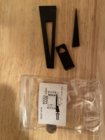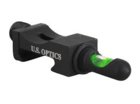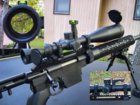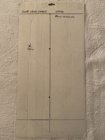Install the app
How to install the app on iOS
Follow along with the video below to see how to install our site as a web app on your home screen.
Note: This feature may not be available in some browsers.
You are using an out of date browser. It may not display this or other websites correctly.
You should upgrade or use an alternative browser.
You should upgrade or use an alternative browser.
Scope Leveling
- Thread starter OmegaRed
- Start date
What is the BEST scope leveling system. I have a Wheeler kit with bubble levels, sick of putting a gun in a barrel vice level and having a scope come out off enough thats its visible to my eye right off the bat.
What is a way to get a scope absolutely perfect every time ?
I find this magnetic scope level works great for me:
http://www.larrywillis.com/

TylerFromMS
Gold $$ Contributor
https://arisakadefense.com/products/optic-leveler
If your rail is level to the bore. Just don't tighten it down if this thing is snug underneath it.
If your rail is level to the bore. Just don't tighten it down if this thing is snug underneath it.
I’m finding that the only thing that you can get truly level is the crosshairs. Not the scope or the rifle. With the crosshairs perfect I’ve found the scope or turrets are not always perfect. The crosshairs are in a tube inside a tube. I think if the manufacturers could get the crosshairs to be perfectly level with the outside tube they would put a mark or even a bubble.
jnm300ultra
Silver $$ Contributor
I use the Wheeler bubble level with a plumb bob. I trust the plumb bob the most. Use hi viz layout line on the plumb bob and a rifle rest. I just switch out three different scope on my hunting rifles tonight. Hope this is helpful.
Jason
Jason
Yes, the "tall target test," but there are a lot of steps to doing it right that are not obvious. See post #27 here for a step-by-step explanation:
http://forum.accurateshooter.com/th...nge-at-300-with-no-wind-at-all.4008086/page-2
http://forum.accurateshooter.com/th...nge-at-300-with-no-wind-at-all.4008086/page-2
avidflyer
Gold $$ Contributor
this with a plumb bob, and good square rings
https://www.badgerordnance.com/gunsmithing-tools/dead-level.html
https://www.badgerordnance.com/gunsmithing-tools/dead-level.html

Check out something called the arisaka tool many different companies make them but it is simple and hard to screw up no bubbles to eyeball if they’re right or not it’s simply slide under the scope on the flat surface and your rail and it mechanically lines up your scope no BSWhat is the BEST scope leveling system. I have a Wheeler kit with bubble levels, sick of putting a gun in a barrel vice level and having a scope come out off enough thats its visible to my eye right off the bat.
What is a way to get a scope absolutely perfect every time ?
Coyotefurharvester
Silver $$ Contributor
I switched scopes last week on the tailgate of my truck, using the wheeler level level and gunvise. Worked perfectly. A secured and level rifle and a plumb Bob and a target will also work very well(distance not a factor). Not all my scoped firearms have a rail or flat action or I would try the arisaka tool, the scope also needs a flat on the bottom of the tube that is perpendicular to the reticle to work. Some entry level optics have a reticle that is off slightly.
F Class John
NRA Life Member
Personally I prefer to set the scope by whatever means necessary (Arisaka, plumb bob or just plain how it looks to me) and then use one of these (or whatever your preferred unit is) and ensure it’s level every time I’m on the line no matter how the target looks through it. Every target hanger is just a little wonky somehow but at least I know that every time I’m on the line my gun is setup exactly the same which is what I care about.


STOMP442
Gold $$ Contributor
I use the Wheeler pro level system and it has worked flawlessly for me. Quick and simple to use.
https://www.midwayusa.com/product/1009244912?pid=189016
https://www.midwayusa.com/product/1009244912?pid=189016
The level question really needs to be narrowed to what you want.
If you're a dialer, you want plumb elevation adjustment.
If you reticle hold over for elevation & wind, you want a plumb reticle.
If you shoot off a bench rest then you want the rest and stock level enough for consistent return to battery.
The action and rings and scope turrets may or may not be true to any of this, but I don't see how it matters.
And with level choices, be sure to use something you can see squarely -while pulling the trigger.
I'm a dialer. With this, I install a 'ScopLevel' and while shooting a box to test the scope I lock in the level true to elevation plumb. This level purely mounts to the scope, so it stays with the scope, forever set, even while I may use the scope for multiple guns over the years.


Consider that for a minute; I move the scope to another gun. I get behind the gun with comfortable hold off my rest (I use Harris bipods). I turn the scope in loose rings until lndicating level under this condition, and lock it down. DONE. I never have to mess with the actual level to do this.
I don't care about slight canting or misalignments of rest/stock/action/bases/rings/turrets/reticle. I only care that my crosshair intersection (my aim point) is true to intended POI -as adjusted via mechanical elevation internals.
That's me. I laser range, dial elevation, and hold off in inches for wind & mirage. My favorite aim point is a simple med-fine cross hair(no Hollywood). I could use a simple dot. Wouldn't matter.
Beyond that, to level the whole system, it seems to me the best time to address it is during stock bedding.
Then if needing plum reticle, you can just set a ScopLevel plumb to that. You can mount extra levels for the gun and rest.
The gun pictured is a Tubb T2K. I had set 12deg of cant in the gun(it's adjustable) because that was very comfortable. No matter, the scope was right.
If you're a dialer, you want plumb elevation adjustment.
If you reticle hold over for elevation & wind, you want a plumb reticle.
If you shoot off a bench rest then you want the rest and stock level enough for consistent return to battery.
The action and rings and scope turrets may or may not be true to any of this, but I don't see how it matters.
And with level choices, be sure to use something you can see squarely -while pulling the trigger.
I'm a dialer. With this, I install a 'ScopLevel' and while shooting a box to test the scope I lock in the level true to elevation plumb. This level purely mounts to the scope, so it stays with the scope, forever set, even while I may use the scope for multiple guns over the years.


Consider that for a minute; I move the scope to another gun. I get behind the gun with comfortable hold off my rest (I use Harris bipods). I turn the scope in loose rings until lndicating level under this condition, and lock it down. DONE. I never have to mess with the actual level to do this.
I don't care about slight canting or misalignments of rest/stock/action/bases/rings/turrets/reticle. I only care that my crosshair intersection (my aim point) is true to intended POI -as adjusted via mechanical elevation internals.
That's me. I laser range, dial elevation, and hold off in inches for wind & mirage. My favorite aim point is a simple med-fine cross hair(no Hollywood). I could use a simple dot. Wouldn't matter.
Beyond that, to level the whole system, it seems to me the best time to address it is during stock bedding.
Then if needing plum reticle, you can just set a ScopLevel plumb to that. You can mount extra levels for the gun and rest.
The gun pictured is a Tubb T2K. I had set 12deg of cant in the gun(it's adjustable) because that was very comfortable. No matter, the scope was right.
https://arisakadefense.com/products/optic-leveler
If your rail is level to the bore. Just don't tighten it down if this thing is snug underneath it.
I love that little tool. Still check with a plumb bob after installing. Sometimes scopes rotate a little when you are torquing it down. I have s bunch of those 1" bubble levels. Haven't used one since I found this tool.
I am not going to trust any leveling tool/gadget without verifying it with the Plumb(er's) Tall Target Test. The test is easy, free and gets your scope positioned exactly right for any distance you want to shoot at.
But if I'm going to do that, I may as well just leave the gadgets out of the process altogether, so that is what I do.
But if I'm going to do that, I may as well just leave the gadgets out of the process altogether, so that is what I do.
I have one and it works as long as there is room to space it under the scope.
https://store.fixitsticks.com/collections/all-shooting/products/scope-jack
https://store.fixitsticks.com/collections/all-shooting/products/scope-jack
I dial my scope, so I do my leveling at the range.
I hang this cardboard target I drew up home, at 100 yards, with a 48” framers level on the vertical line.
Level the rifle in the bags, on the scope rail with a 6” Torpedo level laid flat, so I can see the bubble in the shooting position.
Adjust the scope reticle so it aligns perfectly with the target vertical/horiz lines while keeping the rifle level.
Next, torque the scope caps to 25 in-lb, recheck retical alignment. Then shoot with a couple elevation adjustments.
I hang this cardboard target I drew up home, at 100 yards, with a 48” framers level on the vertical line.
Level the rifle in the bags, on the scope rail with a 6” Torpedo level laid flat, so I can see the bubble in the shooting position.
Adjust the scope reticle so it aligns perfectly with the target vertical/horiz lines while keeping the rifle level.
Next, torque the scope caps to 25 in-lb, recheck retical alignment. Then shoot with a couple elevation adjustments.
Attachments
Last edited:
AJ172SBCT
Silver $$ Contributor
Similar threads
- Replies
- 15
- Views
- 655
- Replies
- 5
- Views
- 915
- Replies
- 22
- Views
- 4,949
Upgrades & Donations
This Forum's expenses are primarily paid by member contributions. You can upgrade your Forum membership in seconds. Gold and Silver members get unlimited FREE classifieds for one year. Gold members can upload custom avatars.

Click Upgrade Membership Button ABOVE to get Gold or Silver Status.
You can also donate any amount, large or small, with the button below. Include your Forum Name in the PayPal Notes field.
To DONATE by CHECK, or make a recurring donation, CLICK HERE to learn how.

Click Upgrade Membership Button ABOVE to get Gold or Silver Status.
You can also donate any amount, large or small, with the button below. Include your Forum Name in the PayPal Notes field.
To DONATE by CHECK, or make a recurring donation, CLICK HERE to learn how.










